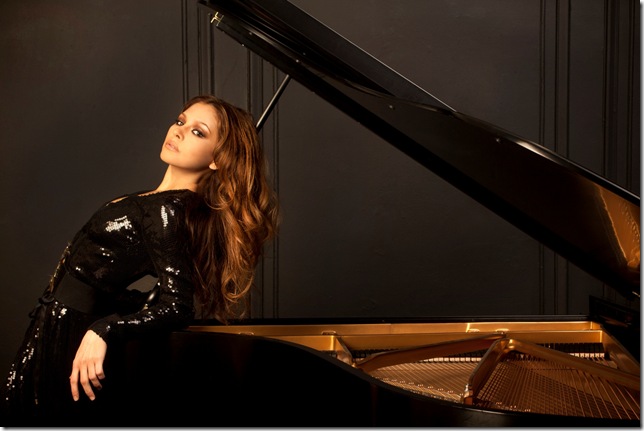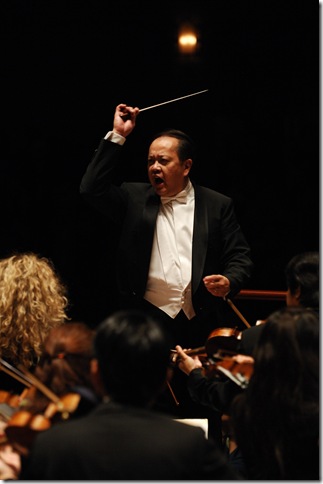It was hard, seeing all those instrumentalists downstage on a closed-in pit at the Kravis Center, not to think of the long-gone Florida Philharmonic.
And perhaps that ultimately was the point of the Palm Beach Symphony’s benefit concert Tuesday night at the Kravis Center, which featured a terrific reading of the Dvorak Eighth Symphony as conducted by a major international conductor, and an impressive performance of the Tchaikovsky First Piano Concerto by an up-and-coming young pianist with serious YouTube cred.
This was a Palm Beach Symphony of 70 players, which is roughly twice the size of the core group, and Executive Director Michael Finn has said he wants to use the Orchestra at St. Luke’s model for the group next year. Its performances in the 2012-13 season will include such things as an evening of wind and string serenades, for example, and perhaps a performance of the Erwin Stein reduction of Mahler’s Fourth Symphony.
But here it was, a full-size orchestra of local musicians, playing with a full-bore Romantic sound and making only a few glitches – a trumpet bobble here, an uncomfortable string stratosphere for the violins there – to speak of. And the house at the Kravis, partly populated by patrons in formal dress coming from a pre-show party and headed to a gala dinner afterward, loved it.
The concert, which was led by Jahja Ling, a Leonard Bernstein protégé who used to lead Tampa’s Florida Orchestra and now leads the San Diego Symphony, opened with the Tchaikovsky First as played by the Uzbek-born pianist Lola Astanova. She has made some serious Internet noise with her bravura etude on Rihanna’s Don’t Stop the Music, and her guiding career inspiration seems to be Vladimir Horowitz; and indeed, she began the evening, as Horowitz sometimes did, with a rich solo version of The Star-Spangled Banner.
Astanova is an attractive woman as well, and she made a striking entrance in a charcoal-gray dress with a fabric flourish at the top and stiff cutaway panels at the legs that she had to hold onto while walking onto the stage. At the keyboard, and in her previous appearance with the orchestra last season, she demonstrated a powerful, muscular approach, and a brilliant technique.
This very familiar concerto came off very well, with a plush first movement that made much of the yearning second theme and the movement’s overall breadth; it was in some ways too plush and could have used a little more energy and fire. The second movement had beautiful playing from solo flute and Astanova, who showed off her lovely singing tone. And while the contrasting fast section that follows had plenty of sparkle, it needed a touch more of the will-o-the-wisp, something lighter and more mysterious.
In the finale, Astanova gave the folk-tune main theme a good sense of joyful rhythm, and drilled those climbing octaves toward the end impressively. Ling and the orchestra were good partners throughout, especially in the very beginning, when there was some slight debate about where the tempo of the main section was going to be.
After a rapturous reception, Astanova returned to the piano for an encore she did not name, but which was the Ocean Etude (in C minor, Op. 25, No. 12) of Chopin, a piece that gave Sergei Rachmaninov almost every compositional building block he needed. And Astanova played it in huge, Rachmaninovian style, in which the sixteenth notes were rattled out like bullets and the initial note of each bar tolled like a great bronze bell.
It fits perfectly with her style, and she is a formidable and attention-getting player. One only wishes for her to add some more lightness and delicacy to her work. She has said she’s going to be focusing on French music in the months ahead, and that should add some other, pastel-like colors to her red-blooded palette.
The second half of the program contained Antonin Dvorak’s finest symphony, the No. 8 (in G, Op. 88). It’s one of Ling’s favorite pieces, and he led it with all the gusto of a salesman who loves his product. And the Palm Beach Symphony was one with him, giving him everything he wanted, and in the end showing their affection by bringing him out for one last curtain call.
Ling led the work from memory, and he guided the audience and his instrumentalists through an enlightening tour of orchestral color and effect. This work is a gift to all orchestral cellists, in that the opening pages of the first movement and the finale are devoted to beautiful melodies sounded in that section. The cellists opened the work with the kind of engaged sound you get from people who know they’re in the spotlight and they’re happy to be there.
The first movement offered listeners the template they would need to frame Ling’s entire approach to this piece, a conception that stressed the composer’s prodigious melodic facility and his first-rate ear for orchestral color, making sure that each little motif, no matter how small, was presented so that it could make maximum impact.
In some ways, the second movement was the best of all. It’s built almost completely on a rising four-note scale used as an upbeat, and it can sound loosely constructed in an indifferent performance. But Ling, and the orchestra that followed him, made sure to wring every bit of meaning and warmth out of the initial statement. In the middle, the strings played their six-note motto with volume and force, adding to its memorability but also helping to show how tightly organized the movement really is.
In the scherzo, there was plenty of old-fashioned portamento in the main theme, which gave it a 19th-century Viennese feel, and the contrasting theme, as well as the quickstep coda, had the crystalline clarity of simple folksong. The finale’s opening theme (which I’ve always thought would make a terrific wedding processional) was faster than many versions I’ve heard, and that helped launch the movement on its way to a fiery, vivid account that saw Ling urging on the various sections to all-out effort.
Imperfections, again, were minor; what mattered was that this was a crackerjack performance from a big local orchestra, and that the audience adored it. These are veteran, expert musicians who have played here in some cases for decades, and they remain the core of the various orchestral excellences hereabouts that do so much to keep South Florida’s cultural level higher than most of its residents are generally aware.
And for all the good that it did for the cause of the Palm Beach Symphony – and no doubt it did – it also was a reminder of what we lost when we lost the Florida Philharmonic, and how vital it is for a large community like this one to have major cultural institutions through which our artistic lives, as well as our lives in general, can be immeasurably enriched.

